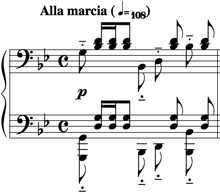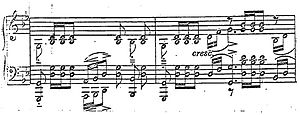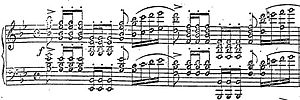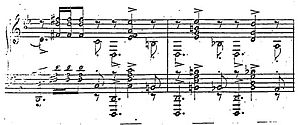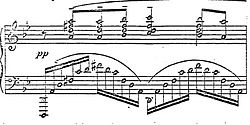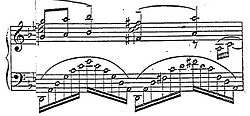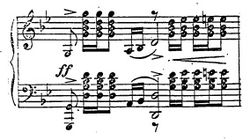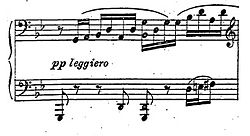- Prelude in G minor (Rachmaninoff)
-
Prelude in G minor, Op. 23, No. 5, was a music piece by Sergei Rachmaninoff, completed in 1901.[1] It was included in his Opus 23 set of ten preludes despite having been written two years earlier than the other nine. It epitomizes Rachmaninoff's Russian nationalism, being rich, in full chords, and with an evocative theme. Rachmaninoff himself premiered the piece in Moscow on February 10, 1903, along with Preludes No. 1 and 2 from Op. 23.[2]
Contents
Structure
The Prelude's taut structure is in ternary form, consisting of an opening "A" section with punctuated sixteenth-note chords (marked Alla marcia), a more lyrical and melancholy "B" section with sweeping arpeggios in the left hand (marked Poco meno mosso), a transition into the original tempo, and a recapitulation of the initial march.
The Alla marcia section is in itself in ternary ABA form. Within the first three measures of the Prelude, Rachmaninoff introduces the unifying factors of the piece (notwithstanding the Poco meno mosso section). First, the chordal march of measure one; second, the fragment on the second half of the beat in measure two; third, the fragment on the second half of beat two in measure three.
Measures 1-9 expand on the march theme. Following a cadence in the dominant, the section repeats in measures 10-16 with slight alterations and concludes in a G minor perfect cadence.
The famous "B" subsection of the Alla marcia section (measures 17-24) mirors the rhythm of the first measure, presenting a sequence of related chords beginning with E flat.
Prior to the lyrical "B" section, in measures 29-35, we see the appearance of Rachmaninoff's "fingerprint": descending chromatic chords over a dominant pedal point.
In contrast to the Alla marcia, the "B" section introduces a lyrical chordal melody over an extended arpeggiated figure. Beginning in measure 35, a two-measure phrase is repeated and then serially extended in measures 39-41. A counter melody appears at measure 42 in the middle voice, intensifying the passage.
Following the middle section, the Prelude transitions to a recaptulation of the march section by gradual increases in tempo and dynamics. The section becomes particularly intense through the use of chromatically upward moving chords following embellished diminished seventh figures.
Finally, despite the bombast of the main march theme, the piece ends in a highly original way: a short arpeggiated run to a high G, marked pianissimo.
Analysis
In line with the Prelude's mostly militant march tempo, rhythm, and dynamics is a strong feeling of tonal center. The A section switches firmly between G minor and D major, with embellishments of half-diminished and diminished seventh chords.
Chord progressions track cleanly around the circle of fifths. In measures 17-25, for example, the pattern is: E flat - B flat - (d) - F - C - g - (A) - D- G. Many of the more evocative modulations in the prelude are a result of a rising or falling chromatic pattern, found frequently in Rachmaninoff's composition.
Clever use of rhythm gives the piece its somewhat "un-Rachmaninoff" feel. The march section is held together by off-beat chords, the middle section is bound by the triplet left hand accompaniment, and the syncopated chords from measures 72-77 give the piece a forward momentum. Meter changes in measures 9 and 16 are a masterstroke, delicately altering the overall sense of phrase balance.
Recordings
This prelude can be found performed in a variety of different styles, many of them in contrast to the composer's own recordings.
There is a famous video in which Emil Gilels plays this Prelude at a front in World War II, in support for the Soviet military forces fighting the war. The narrator says (in Russian): "Gilels is playing at the front, to remind us what the war is worth fighting for: Immortal music!"
This Prelude is one of the most performed and recorded pieces of the op. 23 set, displaying the virtuosity and musical genius of Rachmaninoff.
References
External links
- Opus 23: Free scores at the International Music Score Library Project.
- Video of young Valentina Igoshina playing the prelude
Solo piano works by Sergei Rachmaninoff Morceaux de fantaisie, Op. 3 (includes Prelude in C sharp minor) · Morceaux de salon, Op. 10 · Six moments musicaux, Op. 16 · Variations on a Theme of Chopin, Op. 22 · 10 Preludes, Op. 23 · Piano Sonata No. 1, Op. 28 · 13 Preludes, Op. 32 · Études-Tableaux, Op. 33 · Piano Sonata No. 2, Op. 36 · Études-Tableaux, Op. 39 · Variations on a Theme of Corelli, Op. 42 · Polka de W.R.
Categories:- Preludes by Sergei Rachmaninoff
Wikimedia Foundation. 2010.

